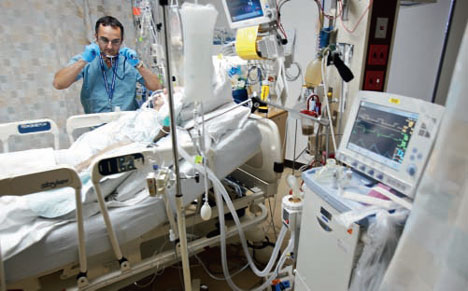Doctors Try New Therapies for COVID-19 Treatment

If patients being supported by oxygen don’t receive enough of it into their bloodstream, doctors may have them placed on a ventilator so they can breathe as their body combats the virus.
Researchers have been working very hard to determine drugs and treatments to combat COVID-19. And, while definitive answers remain unfound, the US Food and Drug Administration announced recently it authorized the emergency use of convalescent blood plasma, a fluid rich in antibodies, donated by COVID-19 survivors.
With the FDA's emergency use authorization or EUA, doctors will find it easier to give current COVID-19 patients donated plasma "as part of their standard course of treatment" at the hospital.
However, news reports said, several experts which include the National Institute of Allergy and Infectious Diseases or NIAID director, Anthony Fauci, recently claimed, further evidence would still be needed on the safety and efficacy of plasma for COVID-19 treatment.
Furthermore, the experts also said, the data from the research use to justify the EUA "was not strong enough."
In a statement, the Infectious Diseases Society of America or IDSA president, Thomas File said, while the data at present several favorable indications that convalescent plasma can contribute treating COVID-19 patients, "specifically if given early in the course of the virus," the randomized controlled trial data are missing. These, he added, are a necessity further to understand its use in the disease's treatment.
ALSO READ: FDA Gives Green Light to Convalescent Plasma for COVID-19 Treatment
Conflicting Advice and Confusion About COVID-19 Information
Reports said the experts' claim against FDA's EUA is not the first time that fast-spreading information about COVID-19 has resulted in "confusion and conflicting advice."
Specifically, in March, the agency authorized the use of hydroxychloroquine and chloroquine, anti-malarial drugs, probably, "out of depression," said medicine and microbiology professor Paul Goepfert.
Then, in June, three months after the authorization of use of the said anti-malarial medicines, as studies growingly cited known dangers and unavailability of benefits, the American College of Physicians said, "that same EUA was revoked."
Scientists worldwide are continuously exploring several possible treatments that range from the low-priced and widely available steroid known as dexamethasone to the "expensive trial antiviral," remdesivir.
DON'T MISS THIS: UK Might Roll Out Antibody Tests With at Least 98% Accuracy by the End of the Year
Potential Treatments
The IDSA came out with guidelines that outline which particular therapies are worthy of testing as potential treatments for COVID-19 that many experts in the field of medicine are still attempting to comprehend.
According to Professor Geopfert, "We're learning a lot" fast more so "than we have with any other virus." However, he added, it will take more comprehensive studies before researchers truly understand which treatment is the most effective.
Medicines that primarily present potential may become more hazardous or not effective. Hundreds of tests are still in progress. Such trials involve thousands of patients not just in the United States but the whole world.
Hospital Care
Most people with COVID-19 can undergo treatment at home and begin to feel better after at least one week. However, based on data from the Centers for Disease Control and Prevention, about a fifth of patients suffer from worsening symptoms like shortness of breath, for one.
People who experience more severe symptoms may need to undergo treatment through hospitalization.
Specifically, Goepfert explained, hospital care is aimed at assisting or helping patients as their body combats the virus.
Such care involves supplemental oxygen for the patients to breathe more easily; intravenous fluids for dehydrated patients, and antibiotics for the treatment of secondary microbial infections like pneumonia, for one.
If patients being supported by oxygen don't receive enough of it into their bloodstream, doctors may have them placed on a ventilator so they can breathe as their body combats the virus.
Vaccine, the Most Promising Intervention
Other than the convalescent plasma and other support equipment, experts say, the most promising intervention to combat COVID-19 and finally go back to the "pre-pandemic life," is immunization.
Indeed, immunizing people will protect them from the virus that leads to COVID-19. More so, scientists have made unparalleled advances toward the fast development of a vaccine.
As of early this week, according to reports, over two dozens vaccines were being tried on humans in clinical tests and over 135 more individuals in earlier phases of development.
IN CASE YOU MISSED THIS: Tricare Issues an Apology Statement After Telling 600k Beneficiaries They've Had COVID-19
Check out more news and information on COVID-19 and Convalescent Plasma on MD News Daily.
Aug 28, 2020 07:00 AM EDT





